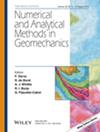Exploring the Elastic Properties of Interfacial Transition Zone in Concrete Materials Using an Ensemble Learning Approach
IF 3.6
2区 工程技术
Q2 ENGINEERING, GEOLOGICAL
International Journal for Numerical and Analytical Methods in Geomechanics
Pub Date : 2025-05-30
DOI:10.1002/nag.4009
引用次数: 0
Abstract
Concrete materials consist of multiple phases with distinct mechanical properties, making it essential to accurately identify the mechanical behavior of both constituent phases and their interfaces for effective multiscale modeling. This study estimates the elastic properties of the interfacial transition zone using a machine learning (ML) approach. A dataset is generated from numerical simulations based on a Fast Fourier Transform method, validated against experimental data. Seven ML models are developed and trained, including four independent artificial neural networks and three ensemble models. The best‐performing ensemble model is identified and described in detail. Further analysis, including over‐fitting analysis, parameter investigation, and sensitivity study, confirms the model's validity and practical applicability.用集成学习方法探索混凝土材料界面过渡区的弹性特性
混凝土材料由具有不同力学性能的多个相组成,因此准确识别两个组成相及其界面的力学行为对于有效的多尺度建模至关重要。本研究使用机器学习(ML)方法估计界面过渡区的弹性特性。基于快速傅里叶变换方法的数值模拟生成了一个数据集,并与实验数据进行了验证。开发并训练了7个ML模型,包括4个独立的人工神经网络和3个集成模型。确定并详细描述了性能最佳的集成模型。进一步的分析,包括过拟合分析、参数调查和敏感性研究,证实了模型的有效性和实用性。
本文章由计算机程序翻译,如有差异,请以英文原文为准。
求助全文
约1分钟内获得全文
求助全文
来源期刊
CiteScore
6.40
自引率
12.50%
发文量
160
审稿时长
9 months
期刊介绍:
The journal welcomes manuscripts that substantially contribute to the understanding of the complex mechanical behaviour of geomaterials (soils, rocks, concrete, ice, snow, and powders), through innovative experimental techniques, and/or through the development of novel numerical or hybrid experimental/numerical modelling concepts in geomechanics. Topics of interest include instabilities and localization, interface and surface phenomena, fracture and failure, multi-physics and other time-dependent phenomena, micromechanics and multi-scale methods, and inverse analysis and stochastic methods. Papers related to energy and environmental issues are particularly welcome. The illustration of the proposed methods and techniques to engineering problems is encouraged. However, manuscripts dealing with applications of existing methods, or proposing incremental improvements to existing methods – in particular marginal extensions of existing analytical solutions or numerical methods – will not be considered for review.

 求助内容:
求助内容: 应助结果提醒方式:
应助结果提醒方式:


